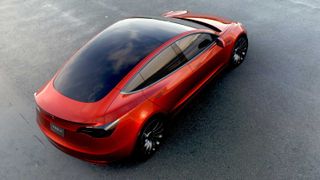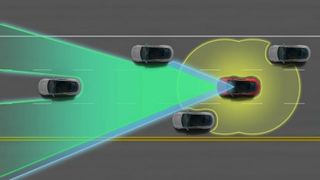
Update: The Model 3 has hit a production bottleneck, meaning that it has fallen far behind the estimates that Tesla CEO Elon Musk originally predicted for delivery. In a series of tweets Musk originally claimed that by December of 2017 the Tesla plant would be producing 20,000 cars a month, but presently only 260 of the cars have actually made it out of the doors.
In a phone call to members of the press, Musk pushed back his estimation of 15,000 cars a month to early 2018.
Original story continues below...
Tesla was founded 13 years ago and shipped its first car in 2008 – the Roadster. At a base price of $109,000 (£86,950, AU$191,888), it was a long shot away from Elon Musk's vision of an affordable electric vehicle (EV).
It took four years before the first Model S reached buyers, which now starts at $70,000 (£50,000, AU$97,245) before incentives and is still not very cheap.
Now that the Model S and X are out the door, Tesla unveiled its first affordable car – the Model 3. Admittedly, the number doesn't make a lot of sense, as it's not the third car from the electric car manufacturer, but it's actually a play on the letter E.
The Model 3 doesn't slot in between the S and X in terms of, well, anything really. But you can see where Tesla was going with this.
According to Fortune, Tesla dropped an application for the Model E after a dispute with Ford who have an on-off relationship with the letter, in use on its E-series of vans.
Cut to the chase
- What is it? Tesla's most affordable EV
- What's the range? 215 miles approx
- How do I reserve one? Tesla store or website with a $1,000 deposit
- When it is out? Out now, although taking time to deliver on pre-orders
- What does it cost? Starts at $35,000 (£30,000, about AU$45,700)
- How fast is it? 0-60 mph is 5.3 seconds
Tesla Model 3: What is it?
The Model 3 is the first affordable Tesla, starting at $35,000 (£30,000, about AU$45,700) before any government tax incentives. It should qualify for the $7,500 federal tax credit for US buyers, which brings the price below $30,000 before state incentives, if you're among the early reservations.
The tax credit is only available for the first 200,000 EVs sold by each manufacturer. According to Electrek, Tesla's cashflow tells the story of over 400,000 pre-orders so meeting the cutoff is pretty unlikely.
If you're in the US, depending on the state you live in, more incentives are available to bring the price down even further. In the UK there are also numerous electric vehicle incentives, so it's worth checking these out if you're thinking of purchasing the Model 3.
Australia still seems to be falling behind in terms of its electric vehicle incentives, although if this changes, we'll let you know.

The Tesla Model 3's simplistic interior
The entry-level Tesla Model 3 is claimed to give you 215 miles from a single charge, and there are plans to offer other configurations like with the Model S and X.
Compared to the 2015 Nissan Leaf rated for 84-miles of range, 215 miles would save the trouble of having to charge in public for 95% of usual driving.
It will feature seating for five adults, losing the two rear-facing seats that the Model S has, and has less than half the trunk volume at 400 liters. There will also be fewer options for configuration with the Model 3 - less than 100 in fact - compared to the Model S that has over 1,500 possible configurations.
Another thing worth noting is that owners of the Model 3 will not benefit from free charging at Tesla Supercharger charging stations like owners of the previous models.
Prices for using Tesla Superchargers vary by location and can be found on the Tesla website.
Tesla Model 3: Will it have Autopilot?
Every Tesla Model 3 will have the hardware for Autopilot technology for semi-autonomous driving, including the base model. We commend Tesla for this announcement as the Nissan Leaf has zero advanced driver assists and the Chevy Bolt will only have basic collision prevention driver assists.
However, Autopilot convenience features, like adaptive cruise control, self-parking and autonomous lane-changing assists are optional. Tesla currently charges $3,000 to add the convenience features to the Model S and X.

How Tesla Autopilot works
Tesla Model 3: How's the performance?
The Model 3 will do 0-60 in 5.3 seconds, making it just slightly faster than the 2015 BMW 228i Convertible, although just slightly slower than the Coupe version.
Advertisement
It will make use of 2170 lithium-ion battery cells engineered in conjunction with Panasonic. Larger battery capacity and performance variants will be available, but that information has not been disclosed.
The Model 3 is rear wheel drive (RWD) with dual motor all-wheel drive (AWD) available as an option. AWD in the Model S costs $5,000 more than its RWD counterpart. Ludicrous mode will be available as an option, too.
In the Model S, Ludicrous mode cut the 0-60 time down to a blistering 2.389 seconds. What this mode will mean for the Model 3 is yet to be revealed, but rest assured you'll never be left behind at a red light again.
Tesla Model 3: What's the competition?
The Tesla Model 3 competes with luxury gasoline and mainstream electric vehicles. On the luxury side, it's base price puts it in the crosshairs of the BMW 3-series, Mercedes C-class, Audi A4 and Lexus IS – all gasoline sedans.
There's also the all-electric BMW i3 and plug-in hybrid electric (PHEV) Audi A3 Sportback e-tron, which have higher base prices but shorter pure-electric range.
The mainstream competition consists of current available EVs, like the Ford Focus Electric, Kia Soul EV, Volkswagen e-Golf and Nissan Leaf. Competition gets tougher if you expand to include PHEV's from Chevrolet, Ford, Hyundai and Kia.
Advertisement

But that's not all, because the competition from EV makers heats up, too. Chevrolet announced the Bolt EV, with 200 miles of all-electric range at CES 2016 and availability by the end of the year.
Nissan is expected to replace the aging Leaf with a newer, longer-range model in the near future, and Hyundai's upcoming all-electric Ioniq is expected to have 110-miles of range.
